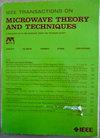A 10.23–15.7-GHz Varactor-Tuned Microstrip Bandpass Filter With Highly Flexible Reconfigurability
IF 4.1
1区 工程技术
Q2 ENGINEERING, ELECTRICAL & ELECTRONIC
IEEE Transactions on Microwave Theory and Techniques
Pub Date : 2021-07-30
DOI:10.1109/TMTT.2021.3098835
引用次数: 13
Abstract
This article demonstrates a 10.23–15.7-GHz varactor-tuned microstrip bandpass filter (BPF) with fully controllable center frequency, bandwidth, and transmission zeros. The concept of cascading a tunable low-pass unit together with a tunable high-pass unit is adopted to achieve the reconfigurable BPF. A comprehensive loss analysis is carried out to determine the preferable circuit topologies for low-pass filter (LPF) and high-pass filter (HPF), respectively. This not only overcomes the limitation of low quality factor of varactor at high frequency, but also contributes to a highly flexible reconfigurability of the BPF. A reconfigurable LPF using defected ground structure (DGS) and a quasi-elliptic HPF using microstrip technology are then proposed to demonstrate the improved BPF performance at high frequency. The measured results show that the designed BPF is capable of operating in five working modes, with a center frequency tuning range from 10.23 to 15.7 GHz and a fractional bandwidth (FBW) tuning range from 32.48% to 95.76%. The minimum in-band insertion loss reaches 2.55 dB. A steep cutoff characteristic and ultrawide stopband with high rejection level are successfully achieved and are well preserved during the whole tuning process, demonstrating the superiority of the designed BPF.具有高度灵活可重构性的10.23 - 15.7 ghz变容调谐微带带通滤波器
本文演示了一个中心频率、带宽和传输零点完全可控的10.23 - 15.7 ghz变容调谐微带带通滤波器(BPF)。采用可调低通单元与可调高通单元级联的概念实现可重构BPF。进行了全面的损耗分析,分别确定了低通滤波器(LPF)和高通滤波器(HPF)的优选电路拓扑。这不仅克服了高频变容器质量因数低的限制,而且有助于BPF具有高度灵活的可重构性。然后提出了一种基于缺陷接地结构(DGS)的可重构LPF和一种基于微带技术的准椭圆型HPF,以证明改进的BPF在高频下的性能。测量结果表明,所设计的BPF能够在5种工作模式下工作,中心频率调谐范围为10.23 ~ 15.7 GHz,分数带宽调谐范围为32.48% ~ 95.76%。最小带内插入损耗达2.55 dB。成功地实现了陡截止特性和高抑制电平的超宽阻带,并在整个调谐过程中保持良好,证明了所设计的BPF的优越性。
本文章由计算机程序翻译,如有差异,请以英文原文为准。
求助全文
约1分钟内获得全文
求助全文
来源期刊

IEEE Transactions on Microwave Theory and Techniques
工程技术-工程:电子与电气
CiteScore
8.60
自引率
18.60%
发文量
486
审稿时长
6 months
期刊介绍:
The IEEE Transactions on Microwave Theory and Techniques focuses on that part of engineering and theory associated with microwave/millimeter-wave components, devices, circuits, and systems involving the generation, modulation, demodulation, control, transmission, and detection of microwave signals. This includes scientific, technical, and industrial, activities. Microwave theory and techniques relates to electromagnetic waves usually in the frequency region between a few MHz and a THz; other spectral regions and wave types are included within the scope of the Society whenever basic microwave theory and techniques can yield useful results. Generally, this occurs in the theory of wave propagation in structures with dimensions comparable to a wavelength, and in the related techniques for analysis and design.
 求助内容:
求助内容: 应助结果提醒方式:
应助结果提醒方式:


